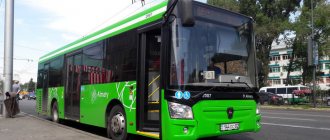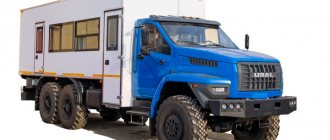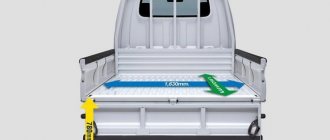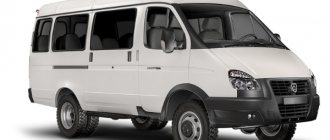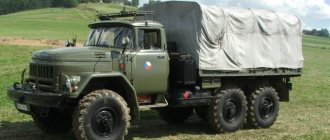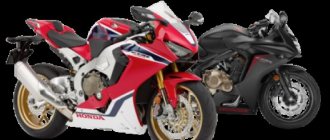Gasoline...Basic equipment
| Fuel consumption rates Please tell me where to find out the basic fuel consumption rate for this 2013 GAZ 2705 car with engine 421640 D, there is no such engine in the 2008 Ministry of Transport order, since it began to be produced recently. Vans are characterized by increased consumption; during the running-in period, diesel consumes up to 18 liters of fuel; after grinding in parts and carrying out routine maintenance, the parameter drops to 11-13 liters. |
Special GAZ-A66R33 • All passenger seats in the cabin are equipped with three-point seat belts.
GAZELLE BUSINESS BOARD
*** The parameters of this indicator vary depending on the engine. These indicators refer to cars with a UMZ-42164 engine (petrol)
All technical specifications are for informational purposes, please check the exact data by calling the numbers listed in the “Contacts” section. All technical specifications are for informational purposes only, please check the exact details by calling the numbers listed in the “Contacts” section. All technical specifications are for informational purposes, please check for exact details by phone numbers listed in the “Contacts” section. All technical specifications are for informational purposes only, please check the exact details by phone numbers listed in the “Contacts” section.
GAZ-3221 | Classification, review, part 1
Hello dear reader! Probably each of you knows about such a car as the GAZelle. Today we will talk specifically about the passenger version of the GAZelle car - GAZ-3221. These cars began to be produced in March 1996 at the Gorky Automobile Plant, which is located in Nizhny Novgorod.
First generation GAZ-3221. Photos from open sources The first generation of GAZ-3221. Photos from open sources
This model has different configurations; GAZelle is still produced, despite the fact that there is a similar model on.
The following passenger models are available:
- GAZ-322100
- GAZ-322105
- GAZ-322120
- GAZ-322121
- GAZ-322125
- GAZ-322130
- GAZ-322131
- GAZ-322132
- GAZ-322133
- GAZ-322135
- GAZ-322153
- GAZ-322170
- GAZ-322171
- GAZ-322173
- GAZ-32219
Also, GAZelles were converted from a 2705 cargo van, they were lengthened, the roof was enlarged, and the interior was redone. Let's move on to their characteristics, differences and differences.
Photo by: drovosek Photos from open sources Photo by: drovosek
GAZ-322100 —
This model has been or is extremely rare in minibus taxis and is distinguished by the availability of seats, that is, it has 8+1 seats. These models were used mainly for some kind of corporate transportation, service ones, and you can also find them on intercity routes; before the appearance of the Largus, they were quite popular. They also changed the seats, adding more if they were in the suburbs or the city. Produced since March 1996, and may have already been discontinued.
Photo author: Denis Rogov Photos from open sources Photo author: Denis Rogov
GAZ-322105 —
This model differs from the GAZ-322100 in interior. The machines have been produced since 2012, seemingly as an order, but are currently out of production. The engine is Ulyanovsk, with propane. They are used in intercity, suburban, and service areas.
Photo by: Archi Photos from open sources Photo by: Archi
GAZ-322120
— a twelve-seater minibus for transporting passengers around the city, intercity, suburbs, as well as for custom and official transportation. This model began to be produced around the mid-2000s, and went into mass production after the transition to the GAZelle Business model, that is, in 2010. Two engine options - Chinese diesel Cummins and Ulyanovsk gasoline Evotek. It seems like they stopped making them this year.
Author of the photo: Danya Photos from open sources. Photos from open sources Photo author: Danya
GAZ-322121
- school minibus. Painted yellow, a petrol or diesel engine is installed, gas engines are not allowed. 2 types of interior configurations - 11+1 or 12+1. A special storage box is installed in the back of the minibus. One front seat, apparently for the accompanying teacher. I haven’t seen them on the routes, although maybe some regional ATP sends them out on a suburban route in the summer to get some fun, who knows)
Photo by: Archi Photo by: Archi
GAZ-322125 —
essentially the same 322120, but with a factory gas system and an Evotek engine. Produced from 2012 until approximately 2019-2020.
Photo author: Archi Photo author: Roma51 Photos from open sources Photo author: Archi
GAZ-322130 —
This model was produced from 1996 to 2013. In fact, one of the most popular models. The engine that was installed was mainly 405, a Trans-Volga engine, not bad, it was running wild on cars with this engine. There were versions with the Volgarevsky imported Chrysler with 137 horses, which didn’t seem to be particularly popular, you can also highlight the ZMZ 410 and GAZ 508. Now the boys in the garages put Japanese “Zuzs” or 1JZ-GE on GAZelle cars, I saw just such a version on 322130. In terms of interior, it differs from others, it is more intended for the suburbs/near intercity, the latest models were equipped with seats from Sotex, they are in the photo.
Fuel consumption. Additional options
78.5 106.8 88.3 120 at crankshaft rotation speed, rpm 4000 3600 Maximum torque, net, N m kgsm 220.5 22.5 270 27.5 at crankshaft rotation speed, rpm 2350 150 1400 -3000. The minibuses used a 98-horsepower 2.89-liter carburetor engine UMZ-4215 from the Ulyanovsk Motor Plant, designed to run on low-octane gasoline AI-80 and not providing sufficiently high dynamic characteristics when operating at full load, which nevertheless made it possible to reduce operational expenses.
Basic characteristics: 11 seats and others. Owner review
| GAZ Gazelle Business 322121. School | DRIVE2 Please tell me where to find out the basic fuel consumption rate for this 2013 GAZ 2705 car with engine 421640 D, there is no such engine in the 2008 Ministry of Transport order, since it began to be produced recently. The NEXT family is divided into two lines, Minibus and Citiline, each of which contains the school modification GAZ-A66R33 and GAZ-A67R42, respectively. |
| GAZ-3221 | Classification, review, part 1 | Ufa transport | Yandex Zen For example, in the Gazelle and Sable product lines, modifications have appeared with an all-wheel drive system and an additional transfer gearbox with a reduction stage, which increases cross-country ability on soft ground or snow-covered fields. Vans are characterized by increased consumption; during the running-in period, diesel consumes up to 18 liters of fuel; after grinding in parts and carrying out routine maintenance, the parameter drops to 11-13 liters. |
Engine capacity of the Gazelle • which burned an average of 16 liters of fuel.
Specifications
Also, GAZelles were converted from a 2705 cargo van, they were lengthened, the roof was enlarged, and the interior was redone. Let's move on to their characteristics, differences and differences.
Petrol
When using spark-ignition engines, the standard fuel consumption depends on the engine model and year of manufacture of the car. at least 11 liters of fuel on the highway at a speed of 80 km/h ; reducing the speed to 60 km/h saves 1.5-2 liters of fuel. Buses and all-metal vans, due to their increased weight, consume 13-14 liters on the highway , and modifications with all-wheel drive burn up to 16.5 liters on the highway .
In urban conditions, vehicles require from 14 (flatbed versions with 4x2 drive) to 20 liters of gasoline (buses on a 4x4 chassis).
Scope of application of the car
"Gazelle" is most often used as:
- public passenger transport, designed for travel around the city and to the suburbs;
- cargo modifications for transporting cargo up to 1-1.5 tons (depending on body type and number of seats);
- some modifications are also used as ambulances.
Be sure to read: Ural timber carrier with hydraulic manipulator
The rigidity of the interior and the lack of necessary protective equipment do not allow long-distance passenger transportation. However, some craftsmen independently convert the interior, but in this case we are most likely talking about illegal routes.
Basic characteristics: 11 seats and others. Chassis characteristics
| Gazelle fuel consumption and its material consumption standards In school buses based on GAZelle Next Citiline, Shkolnik-type passenger seats are equipped with 4-point seat belts and special armrests. Modern technical solutions, components from the world's leading manufacturers, strict quality control, as well as real road statistics allow us to confidently give a full warranty of 3 years or 150,000 km. |
- base chassis for installation of add-ons by third-party companies;
- flatbed trucks with standard and extended wheelbase;
- minibuses and cargo-passenger modifications;
- versions with an all-metal van body.
Technical characteristics • Automatic signal when reversing.
Malfunction of the electronic engine control system
All modern Cummins engines are electronically controlled. The ECU controls mixture formation based on sensor readings. Incorrect operation of the sensors leads to a lean or enriched fuel-air mixture and increased fuel consumption. The main Cummins engine sensors that affect fuel consumption are:
- Atmospheric pressure sensor,
- Boost temperature/pressure sensor,
- Throttle Position Sensor,
- Temperature sensor,
- Crankshaft/camshaft position sensors.
A program failure or incorrect firmware can also affect the fuel consumption of a Cummins engine.
UAZ Patriot - analogue of GAZ
School buses must meet a wide range of requirements and are equipped with a wide range of equipment and options. Popular models produced by the Gorky Automobile Plant are presented below.
Description of the original
Manufacturer: GAZ automobile plant, Nizhny Novgorod Country of production: Russia Type of production: Serial Fuel: Liquid petroleum products
Files
1
A school bus is designed to transport children to schools, colleges, lyceums and other educational institutions. In addition, it can be used for sightseeing trips, trips to the Olympics and other events. The main area of application of school buses in Russia is servicing sparsely populated areas - mainly rural. School buses in this case make it possible to exclude small schools in small settlements. Children from remote settlements are transported to school in a larger settlement.
The first prototype of this type of transport can be considered a horse-drawn cart - a type of transport that moves thanks to an animal. They first began transporting children en masse to school in the first half of the 19th century in London. The capacity of these carts was extremely small. Not everyone could afford to ride it. It transported the children of fairly wealthy parents. A few decades later the first car appeared. A little later, the first school buses were developed. Externally, they were very different from modern buses. Instead of a roof there was a tarpaulin covering, and instead of comfortable and soft chairs there were benches. They became more or less similar to modern transport only in the 30s of the 20th century. There are a number of requirements for the production of school buses. Bright colors, smaller seats than for adults, low height of steps at the entrance and exit, the presence of a special compartment for briefcases, bags, backpacks, the presence of a special separate seat for an adult accompanying a group of children are the main requirements for school bus developers. There are also a number of rules and regulations that must be followed when operating a bus and transporting children. In Russia, until 1999, there were no special technical requirements for buses designed to transport children. For these purposes, ordinary buses were used, on which identification marks “transportation of children” were only installed. In 1999, GOST R 51160-98 “Buses for transporting children. Technical requirements". School buses began to be purchased en masse in 2001, as part of the federal School Bus program. Currently, the supply of school buses to schools is taking place within the framework of the priority national project “Education”.
Design features. Basic characteristics
| The Next Gazelle has turned into a school bus. Today this is an extremely relevant area for bodybuilders, because, according to the Ministry of Education and Science, about thirty thousand of these vehicles are in use in our country, and this year the regions will need about six thousand more new vehicles for transporting children. Fuel consumption The Gazelle Next standard van or flatbed truck with a gasoline engine burns 9.8 liters of fuel under steady state driving conditions; the diesel modification under similar conditions consumes 8.5 liters of diesel fuel. |
| GAZ-322121; Gazelle; minibus for transporting children; Catalog K.V.H. LLC VolgoVyatTsentr-NN From us you can buy a new PAZ school bus, Gazelle school minibus, Mercedes school minibus, Ford school minibus, Fiat school minibus, refurbishment and modification of school buses and minibuses. For the safety of passengers, there are four-point seat belts, a speed limiter up to 60 km/h, blocking the start of movement when the doors are open, a low running board, special mounts for backpacks, etc. |
Equipment
The 12-seat bus from this manufacturer comes in various configurations, which allows each user to choose the most suitable option for themselves. The standard package seems to be the most popular, since it includes all the options necessary for comfortable operation. Among them:
- power steering, adjustable steering wheel;
- brake system equipped with ABS;
- electrically heated rear-view mirrors;
- rear suspension stabilizer;
- radiator insulation;
- cruise control, preheating system (only for diesel units).
Be sure to read: Bus PAZ-4234: technical characteristics
At the same time, the client purchasing this vehicle can expand the package of options by adding the missing functions. GAZ 322122 can be equipped with air conditioning, electric mirrors, fog lights, and a multimedia radio. Also, for an additional fee, the buyer can request anti-corrosion treatment of the body, an enhanced interior heating system, an alarm system and much more.
